High-Precision Inertial Sensor Charge Management Based on Ultraviolet Discharge: A Comprehensive Review
Abstract
1. Introduction
2. The Charge Accumulation of Inertial Sensors
2.1. Inertial Sensor for Space Gravitational Wave Detector and Its Charge Accumulation
2.2. Charge-Induced Acceleration Noise
2.3. Charge Management Requirements for Space Gravitational Wave Detection Mission
- Rapid discharge mode: Discharging the TM potential of V within 1 h requires a maximum discharge rate of e/s (where the total capacitance is 34.2 pF).
- Continuous discharge mode: To counterbalance the anticipated charging effects induced by the on-orbit space environment and to allow for margins, the minimum discharge rate must meet e/s.
3. Charge Management Based on UV Discharge
3.1. Principle of UV Discharge
3.2. Charge Management Method Based on UV Discharge
4. CMS Based on UV Discharge
4.1. Development of CMSs Based on UV Discharge
4.1.1. CMS of GP-B
4.1.2. CMS of LPF
- UV Light Unit (ULU): The ULU consists of six programmable mercury lamps, along with the necessary electronic equipment. To protect the optical element and prevent visible light from entering the inertial sensor, the emitted light from the mercury lamps is filtered by an optical tube and then focused into an optical fiber. Therefore, only UV light with a wavelength of 253.7 nm is used for discharge. Additionally, each lamp housing includes a thermistor, an ohmic heater, and a silicon carbide photodiode to monitor the status of the UV lamps.
- Fiber Optic Harness (FOH): Due to the limitations of the satellite arrangement, the FOH for UV light transmission is composed of 19 optical fibers with a diameter of 200 m. Each lamp is independently connected to transmit light from the ULU located in the outer cabin of the spacecraft to each inertial sensor.
- Inertial Sensor UV Kit (ISUK): The UV light from the fiber is irradiated to the TM and EH at an angle of about 20° through an optical fiber with a diameter of 1 mm and a length of 75 mm. Since a large amount of light will be lost in the groove when the EH is irradiated, in order to reduce the effect of discharge asymmetry, each inertial sensor of LPF has three UV kits, two of which point at the EH and one point at the TM.
4.1.3. CMS of SaudiSat-4
4.2. CMS for Future Space Gravitational Wave Detection
- When selecting an optical fiber, the primary consideration is its transmission efficiency and anti-ultraviolet loss capability. Therefore, the anti-ultraviolet multimode fiber with a large numerical aperture and core diameter should be selected as much as possible [124]. However, due to the difficulty of bending the large core diameter fiber itself (metal coatings allow for reduced bend radius), the size of the core diameter is not the bigger the better and should be weighed against its arrangement carefully.
- When coupling optical fibers with UV lamps, the coupling efficiency is crucial. Other factors such as power consumption, thermal noise, coupling reliability, lifetime, and miniaturization also need to be taken into account. Generally speaking, when using a UV LED light source with a small divergence angle, lens coupling is a more suitable method compared to direct coupling and parabolic lens combination coupling [125]. However, during the actual coupling alignment process, it is important to ensure the co-axiality and alignment of the light source, lens, and fiber to minimize losses due to area adaptation, numerical aperture, and reflection.
- Finally, the design and optimization of the illumination mode of the light outlet should also be emphasized. The incident position determines the proportion of controllable photocurrent (only the photocurrent in the area affected by the electrodes can be controlled), and the incident angle affects the propagation path of UV light inside the inertial sensor, thus influencing the absorption coefficient of UV light on different surfaces. Both of them have a great influence on the discharge efficiency. Some proposals have been made to adjust the optical path by installing a transmitting mirror in the inertial sensor or cutting the fiber section to change the incident angle [126]. However, the feasibility of these ideas still needs to be assessed from an engineering perspective.
5. Conclusions
- Inertial sensors are crucial payloads that provide inertial references for precision space missions. However, the charge accumulation caused by the space environment will inevitably affect their on-orbit performance. To mitigate this issue, it is essential to use a special CMS to reduce the residual charges on the TM and effectively suppress the associated noise. In order to meet the extremely low noise requirements for scientific measurements in space gravitational wave detection, the charge management of its high-precision inertial sensor requires the use of non-contact UV discharge technology. Nevertheless, the related CMS must also meet dynamic range constraints to strike a balance between the charge management requirements with the indirect noise effects resulting from the discharge process.
- The UV discharge uses the photoelectric effect to remove the residual charges on the TM. In order to achieve accurate control of the discharge polarity and rate, it is crucial to adjust the polarity and magnitude of the local bias voltage, considering the complexity of the physical process involved. Currently, there are two widely used charge management methods: DC discharge and AC discharge. The latter has more promising applications as it does not require a special bias voltage. However, its accuracy and effectiveness still largely depend on understanding the photoelectric properties of the surface coating. An adaptive discharge method, which calibrates the compensation coefficient to account for changes in complex physical parameters, can effectively address these issues. Nevertheless, its effectiveness still needs to be verified in actual scenarios.
- Currently, due to extensive research on the ground UV discharge, the non-contact CMS has been successfully implemented in various space missions such as GP-B, LPF, and SaudiSat-4. However, with the increasing demands of future space gravitational wave detection missions, there are still numerous challenges that need to be addressed in the development of CMS. These include measuring and recovering the photoelectric properties of the coating, packaging, and controlling the light source, as well as designing and arranging the optical path.
Author Contributions
Funding
Institutional Review Board Statement
Informed Consent Statement
Data Availability Statement
Conflicts of Interest
Abbreviations
| TM | Test mass |
| EH | Electrode housing |
| CMS | Charge management system |
| UV | Ultraviolet |
| CHAMP | Challenging Minisatellite Payload |
| GRACE | Gravity Recovery and Climate Experiment |
| GOCE | Gravity Field and Steady-State Ocean Circulation Explorer Mission |
| MICROSCOPE | Micro-Satellite with Drag Control for the Observation of the Equivalence Principle |
| GP-B | Gravity Probe B |
| DFACS | Drag-free control system |
| LISA | Laser interferometer space antenna |
| LPF | LISA Pathfinder |
| ULU | UV light unit |
| FOH | Fiber optic harness |
| ISUK | Inertial sensor UV kit |
References
- Everitt, C.W.F.; Muhlfelder, B.; DeBra, D.B.; Parkinson, B.W.; Turneaure, J.P.; Silbergleit, A.S.; Acworth, E.B.; Adams, M.; Adler, R.; Bencze, W.J.; et al. The Gravity Probe B test of general relativity. Class. Quantum Gravity 2015, 32, 224001. [Google Scholar] [CrossRef]
- Touboul, P.; Métris, G.; Rodrigues, M.; André, Y.; Baghi, Q.; Bergé, J.; Boulanger, D.; Bremer, S.; Chhun, R.; Christophe, B.; et al. Space test of the equivalence principle: First results of the MICROSCOPE mission. Class. Quantum Gravity 2019, 36, 225006. [Google Scholar] [CrossRef]
- Racca, G.D.; Mcnamara, P.W. The LISA Pathfinder Mission. Tracing Einstein’s Geodesics in Space. Space Sci. Rev. 2010, 151, 159–181. [Google Scholar] [CrossRef]
- Bettadpur, S.; Tapley, B.; Watkins, M.; Flechtner, F. GRACE Mission: Status and Prospects. In Proceedings of the EGU General Assembly Conference Abstracts, Vienna, Austria, 7–12 April 2013. [Google Scholar]
- Fichter, W.; Gath, P.; Vitale, S.; Bortoluzzi, D. LISA Pathfinder drag-free control and system implications. Class. Quantum Gravity 2005, 22, S139–S148. [Google Scholar] [CrossRef]
- Xiao, C.Y.; Bai, Y.; Li, H.; Liu, L.; Liu, Y.; Luo, J.; Ma, Y.; Qu, S.B.; Tan, D.Y.; Wang, C.R. Drag-free control design and in-orbit validation of TianQin-1 satellite. Class. Quantum Gravity 2022, 39, 155001. [Google Scholar] [CrossRef]
- Araújo, H.; Caizares, P.; Chmeissani, M.; Conchillo, A.; Wass, P. Milli-Hertz Gravitational Waves: LISA and LISA PathFinder. J. Phys. Conf. Ser. 2011, 314, 012014. [Google Scholar] [CrossRef]
- The Taiji Scientific Collaboration. China’s first step towards probing the expanding universe and the nature of gravity using a space borne gravitational wave antenna. Commun. Phys. 2021, 4, 1–7. [Google Scholar]
- Luo, J.; Bai, Y.-Z.; Cai, L.; Cao, B.; Chen, W.-M.; Chen, Y.; Cheng, D.-C.; Ding, Y.-W.; Duan, H.-Z.; Gou, X.; et al. The first round result from the TianQin-1 satellite. Class. Quantum Gravity 2020, 37, 185013. [Google Scholar] [CrossRef]
- Jennrich, O. LISA technology and instrumentation. Class. Quantum Gravity 2009, 26, 153001–153032. [Google Scholar] [CrossRef]
- Everitt, C.; Parmley, R.; Taber, M.; Bencze, W.; Vassar, R. Gravity Probe B cryogenic payload. Class. Quantum Gravity 2015, 32, 224009. [Google Scholar] [CrossRef]
- Grimani, C.; Villani, M.; Fabi, M.; Cesarini, A.; Sabbatini, F. Bridging the gap between Monte Carlo simulations and measurements of the LISA Pathfinder test-mass charging for LISA. Astron. Astrophys. 2022, 666, A38. [Google Scholar] [CrossRef]
- Sumner, T.J.; Shaul, D.N.A.; Schulte, M.O.; Waschke, S.; Hollington, D.; Araújo, H. LISA and LISA Pathfinder charging. Class. Quantum Gravity 2009, 26, 094006. [Google Scholar] [CrossRef]
- Buchman, S.; Byer, R.L.; Gill, D.; Robertson, N.A.; Sun, K.X. Charge neutralization in vacuum for non-conducting and isolated objects using directed low-energy electron and ion beams. Class. Quantum Gravity 2008, 25, 035004. [Google Scholar] [CrossRef][Green Version]
- Letson, B.; Parry, S.; Clark, M.; Olatunde, T.; Barke, S.; Schindler, J.; Diaz Ortiz, M.; Mueller, G.; Sumner, T.; Wass, P. Development of the UV LED-Based Charge Management System for the LISA Gravitational Reference Sensor. Bull. Am. Phys. Soc. 2020, 65, 607–624. [Google Scholar]
- Reigber, C.; Luhr, H.; Schwintzer, P. CHAMP mission status. Adv. Space Res. 2002, 30, 129–134. [Google Scholar] [CrossRef]
- Hećimović, Ž.; Bašić, T. CHAllenging Minisatellite Payload (CHAMP) Satellite Mission. Geod. List. 2005, 59, 129–147. [Google Scholar]
- Tapley, B.D.; Watkins, M.M.; Flechtner, F.; Reigber, C.; Bettadpur, S.; Rodell, M.; Sasgen, I.; Famiglietti, J.S.; Landerer, F.W.; Chambers, D.P. Contributions of GRACE to understanding climate change. Nat. Clim. Chang. 2019, 9, 358–369. [Google Scholar] [CrossRef]
- Tapley, B.; Flechtner, F.; Watkins, M.; Bettadpur, S.; Boening, C. The Current Status and Future Prospects for the GRACE Mission. In Proceedings of the EGU General Assembly Conference Abstracts, Vienna, Austria, 17–22 April 2016. [Google Scholar]
- van der Meijde, M.; Pail, R.; Bingham, R.; Floberghagen, R. GOCE data, models, and applications: A review. Int. J. Appl. Earth Obs. 2015, 35, 4–15. [Google Scholar] [CrossRef]
- Rummel, R.; Gruber, T. Gravity and steady-state ocean circulation explorer GOCE. In System Earth via Geodetic-Geophysical Space Techniques; Springer: Berlin/Heidelberg, Germany, 2010; pp. 203–212. [Google Scholar]
- Josselin, V.; Touboul, P.; Rodrigues, M.; Liorzou, F. MICROSCOPE On-ground and In-orbit Calibration. Space Sci. Rev. 2010, 151, 25–38. [Google Scholar] [CrossRef]
- Touboul, P.; Métris, G.; Rodrigues, M.; Bergé, J.; Robert, A.; Baghi, Q.; André, Y.; Bedouet, J.; Boulanger, D.; Bremer, S. MICROSCOPE Mission: Final Results of the Test of the Equivalence Principle. Phys. Rev. Lett. 2022, 129, 121102. [Google Scholar] [CrossRef]
- Li, L. The Effects of Seismic Noise and Discharging Wire for the Performance Measurement of Inertial Sensor Based on Torsion Pendulum Scheme. Ph.D. Thesis, Huazhong University of Science & Technology, Wuhan, China, 2012. [Google Scholar]
- Wang, C.; Bai, Y.; Cai, L.; Hu, M.; Liu, L.; Ma, Y.; Qu, S.; Wu, S.; Yin, H.; Yu, J.; et al. High precision electrostatic inertial sensor. Sci. Sin. Phys. Mech. Astron. 2023, 53, 250401. [Google Scholar] [CrossRef]
- Buchman, S.; Quinn, T.; Keiser, G.M.; Gill, D.; Sumner, T.J. Charge measurement and control for the Gravity Probe B gyroscopes. Rev. Sci. Instrum. 1995, 66, 120–129. [Google Scholar] [CrossRef]
- Clark, M.; Letson, B.; Parry-Kenyon, S.; Olatunde, T.; Barke, S.; Mueller, G.; Sumner, T.; Wass, P.; Storm, M.; Conklin, J. A UV LED-Based Charge Management System for the LISA Gravitational Reference Sensor. In Proceedings of the APS April Meeting Abstracts, Virtual, 17–20 April 2021. [Google Scholar]
- Buchman, S.; Al Saud, T.S.M.; Alfauwaz, A.; Byer, R.I.; Klupar, P.; Lipa, J.; Lui, C.Y.; Saraf, S.; Wang, S.; Worden, P. Flight and ground demonstration of reproducibility and stability of photoelectric properties for passive charge management using LEDs. Class. Quantum Gravity 2023, 40, 025026. [Google Scholar] [CrossRef]
- Buchman, S.; Lipa, J.A.; Keiser, G.M.; Muhlfelder, B.; Turneaure, J.P. The Gravity Probe B gyroscope. Class. Quantum Gravity 2015, 32, 224004. [Google Scholar] [CrossRef]
- Will, C.M. Finally, results from gravity probe-B. arXiv 2011, arXiv:1106.1198. [Google Scholar] [CrossRef]
- Shaul, D.; Araújo, H.; Rochester, G.K.; Schulte, M.; Sumner, T.J.; Trenkel, C.; Wass, P. Charge management for LISA and LISA pathfinder. Int. J. Mod. Phys. D 2008, 17, 993–1003. [Google Scholar] [CrossRef]
- Staff of the Space Department, The Johns Hopkins University Applied Physics Laboratory, Silver Spring, MD and Staff of the Guidance and Control Laboratory. A Satellite Freed of all but Gravitational Forces: “TRIAD I”. J. Spacecr. Rocket. 1974, 11, 637–644. [Google Scholar] [CrossRef]
- Dávila Álvarez, A.; Knudtson, A.; Patel, U.; Gleason, J.; Hollis, H.; Sanjuan, J.; Doughty, N.; McDaniel, G.; Lee, J.; Leitch, J. A simplified gravitational reference sensor for satellite geodesy. J. Geod. 2022, 96, 70. [Google Scholar] [CrossRef]
- Schleicher, A.; Ziegler, T.; Schubert, R.; Brandt, N.; Bergner, P.; Johann, U.; Fichter, W.; Grzymisch, J. In-orbit performance of the LISA Pathfinder drag-free and attitude control system. CEAS Space J. 2018, 10, 471–485. [Google Scholar] [CrossRef]
- Lange, B. The Drag-Free Satellite. AIAA J. 1964, 2, 1590–1606. [Google Scholar] [CrossRef]
- Drinkwater, M.R.; Floberghagen, R.; Haagmans, R.; Muzi, D.; Popescu, A. GOCE: ESA’s first earth explorer core mission. Space Sci. Rev. 2003, 108, 419–432. [Google Scholar] [CrossRef]
- Anza, S.; Armano, M.; Balaguer, E.; Zweifel, P. The LTP experiment on the LISA Pathfinder mission. Class. Quantum Gravity 2005, 22, S125–S138. [Google Scholar] [CrossRef]
- Deng, J.-f.; Cai, Z.-m.; Chen, K.; Shi, X.-j.; Yu, J.-p.; Li, H.-w. Drag-free control and its application in China’s space gravitational wave detection. Chin. Opt. 2019, 12, 503–514. [Google Scholar] [CrossRef]
- Lauben, D.; Allen, G.; Bencze, W.; Buchman, S.; Byer, R.; Goh, A.; Dorlybounxou, S.; Hanson, J.; Ho, L.; Higuchi, S.; et al. Electrostatic sensing and forcing electronics performance for the LISA Pathfinder gravitational reference sensor. In Proceedings of the 6th International LISA Symposium, Greenbelt, MD, USA, 19–23 June 2006. [Google Scholar]
- Armano, M.; Audley, H.; Baird, J.; Born, M.; Bortoluzzi, D.; Cardines, N.; Castelli, E.; Cavalleri, A.; Cesarini, A.; Cruise, A.M.; et al. Analysis of the accuracy of actuation electronics in the laser interferometer space antenna pathfinder. Rev. Sci. Instrum. 2020, 91, 045003. [Google Scholar] [CrossRef] [PubMed]
- Gerndt, R.; Fichter, W.; Brandt, N.; Gerardi, D.; Montemurro, F.; Schleicher, A.; Ziegler, T.; Johann, U. LISA Technology Package System Design And Operations. In Proceedings of the 6th International LISA Symposium, Greenbelt, MD, USA, 19–23 June 2006; pp. 668–674. [Google Scholar]
- Antonucci, F.; Armano, M.; Audley, H.; Auger, G.; Zweifel, P. From laboratory experiments to LISA Pathfinder: Achieving LISA geodesic motion. Class. Quantum Gravity 2010, 28, 094002. [Google Scholar] [CrossRef]
- Mance, D. Development of Electronic System for Sensing and Actuation of Test Mass of the Inertial Sensor LISA. Ph.D. Thesis, University of Split, Split, Croatia, 2012. [Google Scholar]
- Armano, M.; Audley, H.; Auger, G.; Baird, J.T.; Bassan, M.; Binetruy, P.; Born, M.; Bortoluzzi, D.; Brandt, N.; Caleno, M.; et al. Sub-Femto- g Free Fall for Space-Based Gravitational Wave Observatories: LISA Pathfinder Results. Phys. Rev. Lett. 2016, 116, 231101. [Google Scholar] [CrossRef] [PubMed]
- Fichter, W.; Schleicher, A.; Brandt, N.; Vitale, S.; Bortoluzzi, D. Control Tasks and Functional Architecture of the LISA Pathfinder Drag-Free System. In Proceedings of the 6th International ESA Conference on Guidance, Navigation and Control Systems, Loutraki, Greece, 17–20 October 2005. [Google Scholar]
- Hollington, D. The Charge Management System for LISA and LISA Pathfinder. Ph.D. Thesis, Imperial College London, London, UK, 2011. [Google Scholar]
- Jafry, Y.; Sumner, T.J. Electrostatic charging of the LISA proof masses. Class. Quantum Gravity 1997, 14, 1567–1574. [Google Scholar] [CrossRef]
- Armano, M.; Audley, H.; Baird, J.; Binetruy, P. Measuring the Galactic Cosmic Ray Flux with the LISA Pathfinder Radiation Monitor. Astropart. Phys. 2017, 98, 28–37. [Google Scholar] [CrossRef]
- Han, R.; Cai, M.; Yang, T.; Xu, L.; Xia, Q.; Jia, X.; Gao, D.; Han, J. Effect of solar proton events on test mass for gravitational wave detection in the 24th solar cycle. Sci. Rep. 2023, 13, 9932. [Google Scholar] [CrossRef]
- Villani, M.; Cesarini, A.; Fabi, M.; Grimani, C. Role of plasmons in the LISA test-mass charging process. Class. Quantum Gravity 2021, 38, 145005. [Google Scholar] [CrossRef]
- Taioli, S.; Dapor, M.; Dimiccoli, F.; Fabi, M.; Ferroni, V.; Grimani, C.; Villani, M.; Weber, W.J.J.C.; Gravity, Q. The role of low-energy electrons in the charging process of LISA test masses. Class. Quantum Gravity 2023, 40, 075001. [Google Scholar] [CrossRef]
- Sumner, T.J.; Jafry, Y. The radiation environment for the LISA and MiniSTEP missions and test mass charge control. Adv. Space Res. 2000, 25, 1219–1223. [Google Scholar] [CrossRef]
- Grimani, C.; Fabi, M.; Lobo, A.J.; Mateos, I.; Telloni, D. Role of GCR positive and negative particles in charging the LISA-PF test masses in 2015. J. Phys. Conf. 2015, 610, 012025. [Google Scholar] [CrossRef]
- Shaul, D.; Sumner, T.J.; Rochester, G.K. Coherent Fourier Components in the LISA Measurement Bandwidth from Test Mass Charging: Estimates and Suppression. Int. J. Mod. Phys. D 2005, 14, 51–71. [Google Scholar] [CrossRef]
- Shaul, D.N.A.; Sumner, T.J.; Araujo, H.M.; Rochester, G.K.; Wass, P.J.; Lee, C.G.Y. Unwanted, coherent signals in the LISA bandwidth due to test mass charging. Class. Quantum Gravity 2004, 21, S647–S651. [Google Scholar] [CrossRef]
- Sumner, T.; Araujo, H.; Davidge, D.; Howard, A.; Lee, C.; Rochester, G.; Shaul, D.; Wass, P. Description of charging/discharging processes of the LISA sensors. Class. Quantum Gravity 2004, 21, S597–S602. [Google Scholar] [CrossRef]
- Vocca, H.; Grimani, C.; Amico, P.; Bosi, L.; Marchesoni, F.; Punturo, M.; Travasso, F.; Barone, M.; Stanga, R.; Vetrano, F.; et al. Simulation of the charging process of the LISA test masses due to solar flares. Class. Quantum Gravity 2004, 21, S665–S670. [Google Scholar] [CrossRef]
- Armano, M.; Audley, H.; Auger, G.; Baird, J.T.; Binetruy, P.; Born, M.; Bortoluzzi, D.; Brandt, N.; Bursi, A.; Caleno, M.; et al. Charge-Induced Force Noise on Free-Falling Test Masses: Results from LISA Pathfinder. Phys. Rev. Lett. 2017, 118, 171101. [Google Scholar] [CrossRef]
- Villani, M.; Benella, S.; Fabi, M.; Grimani, C. Low-energy electron emission at the separation of gold-platinum surfaces induced by galactic cosmic rays on board LISA Pathfinder. Appl. Surf. Sci. 2020, 512, 145734. [Google Scholar] [CrossRef]
- Xia, M. Analysis of the Impact of Major Environmental Disturbances on Space Gravitational Reference Sensor: LISA Pathfinder to LISA. Master’s Thesis, Huazhong University of Science & Technology, Wuhan, China, 2020. [Google Scholar]
- Sumner, T.J.; Mueller, G.; Conklin, J.W.; Wass, P.J.; Hollington, D. Charge induced acceleration noise in the LISA gravitational reference sensor. Class. Quantum Gravity 2020, 37, 045010. [Google Scholar] [CrossRef]
- Shaul, D.N.A.; Araújo, H.M.; Rochester, G.K.; Sumner, T.J.; Wass, P.J. Evaluation of disturbances due to test mass charging for LISA. Class. Quantum Gravity 2005, 22, S297–S309. [Google Scholar] [CrossRef]
- Sala, L. Residual Test Mass Acceleration in LISA Pathfinder: In-Depth Statistical Analysis and Physical Sources. Ph.D. Thesis, University of Trento, Trento, Italy, 2023. [Google Scholar]
- Araújo, H.M.; Wass, P.; Shaul, D.; Rochester, G.; Sumner, T.J. Detailed calculation of test-mass charging in the LISA mission. Astropart. Phys. 2005, 22, 451–469. [Google Scholar] [CrossRef]
- Diaz-Aguiló, M.; García-Berro, E.; Lobo, A. Inflight magnetic characterization of the test masses onboard LISA Pathfinder. Phys. Rev. D 2012, 85, 042004. [Google Scholar] [CrossRef]
- Antonucci, F.; Cavalleri, A.; Dolesi, R.; Hueller, M.; Nicolodi, D.; Tu, H.B.; Vitale, S.; Weber, W.J. Interaction between stray electrostatic fields and a charged free-falling test mass. Phys. Rev. Lett. 2012, 108, 181101. [Google Scholar] [CrossRef]
- Vocca, H.; Grimani, C.; Amico, P.; Gammaitoni, L.; Marchesoni, F.; Bagni, G.; Marconi, L.; Stanga, R.; Vetrano, F.; Viceré, A. Simulation of the charging process of the LISA test masses due to solar particles. Class. Quantum Gravity 2005, 22, S319–S325. [Google Scholar] [CrossRef]
- Araujo, H.M.; Howard, A.; Davidge, D.; Sumner, T.J. Charging of isolated proof masses in satellite experiments such as LISA. In Proceedings of the Conference on Gravitational-Wave Detection, Waikoloa, Hi, USA, 23–25 August 2003. [Google Scholar]
- Ziegler, T.; Fichter, W.; Schulte, M.; Vitale, S. Principles, operations, and expected performance of the LISA Pathfinder charge management system. J. Phys. Conf. Ser. 2009, 154, 012009. [Google Scholar] [CrossRef]
- Kenyon, S.P.; Letson, B.; Clark, M.; Olatunde, T.; Ritten, L.; Schindler, J.; Wass, P.J.; Conklin, J.W.; Barke, S.; Mueller, G.; et al. A Charge Management System for Gravitational Reference Sensors—Design and Instrument Testing. In Proceedings of the 2021 IEEE Aerospace Conference, Big Sky, MT, USA, 6–13 March 2021; pp. 1–9. [Google Scholar]
- Reynolds, G.M.; Vassar, R.H.; Parmley, R.T.; Read, D.; Reeve, W.; Shaul, K.; Clair, D.S.; Beukel, J. Payload and spacecraft technology for GP-B. Adv. Space Res. 2000, 25, 1193–1197. [Google Scholar] [CrossRef]
- Braojos Gutierrez, M.; Kenyon, S.; Letson, B.; Barke, S.; Schindler, J.; Wass, P.; Conklin, J.W. Short Wavelength UV LED Lens System to Attenuate Noise in LISA. In Proceedings of the AIAA SCITECH 2023 Forum, National Harbor, MD, USA, 23–27 January 2023. [Google Scholar]
- Ziegler, T.; Bergner, P.; Hechenblaikner, G.; Brandt, N.; Fichter, W. Modeling and performance of contact-free discharge systems for space inertial sensors. IEEE Trans. Aerosp. Electron. Syst. 2014, 50, 1493–1510. [Google Scholar] [CrossRef]
- Hechenblaikner, G.; Ziegler, T.; Biswas, I.; Seibel, C.; Schulze, M.; Brandt, N.; Schoell, A.; Bergner, P.; Reinert, F.T. Energy distribution and quantum yield for photoemission from air-contaminated gold surfaces under UV illumination close to the threshold. J. Appl. Phys. 2012, 111, 549–567. [Google Scholar] [CrossRef]
- Einstein, A. Über einem die Erzeugung und Verwandlung des Lichtes betreffenden heuristischen Gesichtspunkt. Ann. Der Phys. 1905, 4, 132–148. [Google Scholar] [CrossRef]
- Fowler, R.H. The analysis of photoelectric sensitivity curves for clean metals at various temperatures. Phys. Rev. D 1931, 38, 45–55. [Google Scholar] [CrossRef]
- Dowell, D.H.; Schmerge, J.F. Quantum efficiency and thermal emittance of metal photocathodes. Phys. Rev. Spec. Top.-Accel. Beams 2009, 12, 074201. [Google Scholar] [CrossRef]
- Pei, Z.; Berglund, C.N. Angular Distribution of Photoemission from Gold Thin Films. Jpn. J. Appl. Phys. 2002, 41, L52–L54. [Google Scholar] [CrossRef]
- Apple, S. Design and Performance Characterization of a New LISA-like Gravitational Reference Sensor and Torsion Pendulum Testbed. Ph.D. Thesis, University Of Florida, Gainesville, FL, USA, 2020. [Google Scholar]
- Olatunde, T.; Apple, S.; Inchauspé, H.; Parry, S.; Letson, B.; Wass, P.J.; Mueller, G.; Conklin, J.W. Characterisation of Au surface properties relevant for UV photoemission-based charge control for space inertial sensors. Class. Quantum Gravity 2020, 37, 195009. [Google Scholar] [CrossRef]
- Schulte, M.; Rochester, G.K.; Shaul, D.N.A.; Sumner, T.J.; Trenkel, C.; Wass, P.J. The charge-management system on LISA-Pathfinder—Status & outlook for LISA. In Proceedings of the 6th International Laser Interferometer Space Antenna, Greenbelt, MD, USA, 19–23 June 2006. [Google Scholar]
- Schulte, M.O.; Shaul, D.N.A.; Hollington, D.; Waschke, S.; Sumner, T.J.; Wass, P.J.; Pasquali, L.; Nannarone, S. Inertial sensor surface properties for LISA Pathfinder and their effect on test mass discharging. Class. Quantum Gravity 2009, 26, 094008. [Google Scholar] [CrossRef]
- Balakrishnan, K. Design, Demonstration, and Space Qualification of an Ultraviolet LED Based Charge Management System. Ph.D. Thesis, Stanford University, Stanford, CA, USA, 2016. [Google Scholar]
- Sun, K.X.; Higuchi, S.; Goh, A.; Allard, B.; Byer, R. Spectral and Power Stability Tests of Deep UV LEDs for AC Charge Management. In Proceedings of the 6th International LISA Symposium, Greenbelt, MD, USA, 19–23 June 2006. [Google Scholar]
- Yang, F.; Bai, Y.; Hong, W.; Sumner, T.J.; Zhou, Z. A charge control method for space-mission inertial sensor using differential UV LED emission. Rev. Sci. Instrum. 2020, 91, 124502. [Google Scholar] [CrossRef]
- Pi, X.; Liu, Q.; Xu, J.; Zhu, L.; Wang, Q.; Zhang, Y.; Yang, S.; Luo, J. Continuous charge management scheme for TianQin. Class. Quantum Gravity 2023, 40, 035005. [Google Scholar] [CrossRef]
- Wang, S.; Saraf, S.; Lipa, J.; Yadav, D.; Buchman, S. Two approaches for the passive charge management of contactless test masses. Class. Quantum Gravity 2022, 39, 195008. [Google Scholar] [CrossRef]
- Tombolato, D. A Laboratory Study of Force Disturbances for the LISA Pathfinder Free Fall Demonstration Mission. Ph.D. Thesis, University of Trento, Trento, Italy, 2008. [Google Scholar]
- Dal Bosco, D. Torsion Pendulum Testing of the LISA Charge Management System. Ph.D. Thesis, University of Trento, Trento, Italy, 2023. [Google Scholar]
- Pollack, S.E.; Turner, M.D.; Schlamminger, S.; Hagedorn, C.A.; Gundlach, J.H. Charge management for gravitational-wave observatories using UV LEDs. Phys. Rev. D 2010, 81, 021101. [Google Scholar] [CrossRef]
- Wass, P.J.; Hollington, D.; Sumner, T.J.; Yang, F.; Pfeil, M. Effective decrease of photoelectric emission threshold from gold plated surfaces. Rev. Sci. Instrum. 2019, 90, 064501. [Google Scholar] [CrossRef]
- Balakrishnan, K.; Sun, K.-X.; Alfauwaz, A.; Aljadaan, A.; Almajeed, M.; Alrufaydah, M.; Althubiti, S.; Aljabreen, H.; Buchman, S.; Byer, R.L.; et al. UV LED charge control of an electrically isolated proof mass in a Gravitational Reference Sensor configuration at 255 nm. In Proceedings of the 39th COSPAR Scientific Assembly, Mysore, India, 14–22 July 2012. [Google Scholar]
- Saraf, S.; Buchman, S.; Balakrishnan, K.; Lui, C.Y.; Soulage, M.; Faied, D.; Hanson, J.; Ling, K.; Jaroux, B.; Suwaidan, B.A.; et al. Ground testing and flight demonstration of charge management of insulated test masses using UV-LED electron photoemission. Class. Quantum Gravity 2016, 33, 245004. [Google Scholar] [CrossRef]
- Ciani, G.; Chilton, A.; Apple, S.; Olatunde, T.; Aitken, M.; Mueller, G.; Conklin, J.W. A new torsion pendulum for gravitational reference sensor technology development. Rev. Sci. Instrum. 2017, 88, 064502. [Google Scholar] [CrossRef]
- Inchauspé, H.; Olatunde, T.; Apple, S.; Parry, S.; Letson, B.; Turetta, N.; Mueller, G.; Wass, P.J.; Conklin, J.W. Numerical modeling and experimental demonstration of pulsed charge control for the space inertial sensor used in LISA. Phys. Rev. D 2020, 102, 042002. [Google Scholar] [CrossRef]
- Apple, S.; Alvarez, A.D.; Kenyon, S.P.; Chilton, A.; Klein, D.; Bickerstaff, B.; Barke, S.; Clark, M.; Letson, B.; Olatunde, T.; et al. Design and performance characterization of a new LISA-like (laser interferometer space antenna-like) gravitational reference sensor and torsion pendulum testbed. Rev. Sci. Instrum. 2023, 94, 054502. [Google Scholar] [CrossRef] [PubMed]
- Yang, F.; Bai, Y.; Hong, W.; Li, H.; Liu, L.; Sumner, T.J.; Yang, Q.; Zhao, Y.; Zhou, Z. Investigation of charge management using UV LED device with a torsion pendulum for TianQin. Class. Quantum Gravity 2020, 37, 115005. [Google Scholar] [CrossRef]
- Hao, C. The Charge Management Research in the Torsion Pendulum. Master’s Thesis, Huazhong University of Science & Technology, Wuhan, China, 2013. [Google Scholar]
- Yang, F. Investigation of Charge Management and Control for Space Inertial Sensors. Ph.D. Thesis, Huazhong University of Science & Technology, Wuhan, China, 2020. [Google Scholar]
- Kang, W.; Li, D.; Li, G.; Han, X. Research on UV Light Control Technology for Detecting Mass Charge with Gravitational Reference Sensor. Vac. Cryog. 2021, 27, 407–410. [Google Scholar]
- Everitt, C.F.; DeBra, D.; Parkinson, B.; Turneaure, J.; Conklin, J.; Heifetz, M.; Keiser, G.; Silbergleit, A.; Holmes, T. Kolodziejczak, Gravity probe B: Final results of a space experiment to test general relativity. Phys. Rev. Lett. 2011, 106, 221101. [Google Scholar] [CrossRef]
- Buchman, S.; Bencze, W.; Brumley, R.; Clarke, B.; Keiser, G.M. The design and testing of the Gravity Probe B suspension and charge control systems. In Proceedings of the 2nd International LISA Symposium, Pasadena, CA, USA, 12–14 July 1998. [Google Scholar]
- Armano, M.; Audley, H.; Baird, J.; Binetruy, P.; Born, M.; Bortoluzzi, D.; Castelli, E.; Cavalleri, A.; Cesarini, A.; Cruise, A.M.; et al. Beyond the Required LISA Free-Fall Performance: New LISA Pathfinder Results down to 20 muHz. Phys. Rev. Lett. 2018, 120, 061101. [Google Scholar] [CrossRef] [PubMed]
- Anderson, G.; Anderson, J.; Anderson, M.; Aveni, G.; Bame, D.; Barela, P.; Blackman, K.; Carmain, A.; Chen, L.; Cherng, M.; et al. Experimental results from the ST7 mission on LISA Pathfinder. Phys. Rev. D 2018, 98, 102005. [Google Scholar] [CrossRef]
- Wass, P.J.; Araújo, H.; Shaul, D.; Sumner, T.J. Test-mass charging simulations for the LISA Pathfinder mission. Class. Quantum Gravity 2005, 22, S311–S317. [Google Scholar] [CrossRef]
- Wass, P.J.; Carbone, L.; Cavalleri, A.; Ciani, G.; Weber, W. Testing of the UV discharge system for LISA Pathfinder. Am. Inst. Phys. 2006, 23, 220–224. [Google Scholar]
- Armano, M.; Audley, H.; Baird, J.; Binetruy, P.; Born, M.; Bortoluzzi, D.; Castelli, E.; Cavalleri, A.; Cesarini, A.; Cruise, A.M.; et al. Precision charge control for isolated free-falling test masses: LISA pathfinder results. Phys. Rev. D 2018, 98, 062061. [Google Scholar] [CrossRef]
- Sun, K.-X.; Allard, B.; Buchman, S.; Williams, S.; Byer, R.L. LED deep UV source for charge management of gravitational reference sensors. Class. Quantum Gravity 2006, 23, S141–S150. [Google Scholar] [CrossRef]
- Yang, C.; Wang, X.; Fan, B.; Xie, J. Applications and research progress of ultraviolet light-emitting diodes. J. Foshan Univ. (Nat. Sci. Ed.) 2021, 39, 57–65. [Google Scholar]
- Warren, C.; Dunbar, N.; Backler, M. Engineering of the LISA Pathfinder mission—Making the experiment a practical reality. Class. Quantum Gravity 2009, 26, 094002. [Google Scholar] [CrossRef]
- Armano, M.; Audley, H.; Baird, J.; Binetruy, P.; Born, M.; Bortoluzzi, D.; Castelli, E.; Cavalleri, A.; Cesarini, A.; Cruise, A.M.; et al. LISA Pathfinder platform stability and drag-free performance. Phys. Rev. D 2019, 99, 082001. [Google Scholar] [CrossRef]
- Olatunde, T.; Shelley, R.; Chilton, A.; Serra, P.; Ciani, G.; Mueller, G.; Conklin, J. 240 nm UV LEDs for LISA test mass charge control. J. Phys. Conf. Ser. 2015, 610, 012034. [Google Scholar] [CrossRef]
- Tian, J. Surface Structure Research of Electrified Test Mass in Charge Management. Master’s Thesis, Lanzhou University, Lanzhou, China, 2023. [Google Scholar]
- Sachtler, W.; Dorgelo, G.; Holscher, A.A. The work function of gold. Surf. Sci. 1966, 5, 221–229. [Google Scholar] [CrossRef]
- Zhu, R.; Zhao, Z.; An, C.; Xu, J. Influence of surface adsorbed contamination on polycrystalline copper and gold functionals. J. Chin. Electron Microsc. Soc. 2018, 37, 251–256. [Google Scholar]
- Letson, B.C.; Conklin, J.W.; Wass, P.; Barke, S.; Mueller, G.; Rasel, M.A.J.; Haque, A.; Pearton, S.J.; Ren, F. Review—Reliability and Degradation Mechanisms of Deep UV AlGaN LEDs. ECS J. Solid State Sci. Technol. 2023, 12, 066002. [Google Scholar] [CrossRef]
- Hollington, D.; Baird, J.T.; Sumner, T.J.; Wass, P.J. Characterising and testing deep UV LEDs for use in space applications. Class. Quantum Gravity 2015, 32, 235020. [Google Scholar] [CrossRef]
- Sun, K.X. AlGaN UV LED and Photodiodes Radiation Hardness and Space Qualifications and Their Applications in Space Science and High Energy Density Physics. In Proceedings of the Advanced Microelectronics and Photonics for Space, San Diego, CA, USA, 1–3 June 2011. [Google Scholar]
- Barke, S.; Richardson, C.; Letson, B.; Kenyon, S.; Mueller, G.; Sumner, T.; Wass, P.; Storm, M.; Conklin, J. Ensuring Reliability in Space: Environmental Testing of a UV-LED Based Charge Management System for the LISA Gravitational Wave Observatory. Bull. Am. Phys. Soc. 2023, 68, 322–349. [Google Scholar]
- Letson, B.C. Assessment and Enhancement of Deep UV LED Reliability for Long Duration Space Missions. Ph.D. Thesis, University of Florida, Gainesville, FL, USA, 2022. [Google Scholar]
- Letson, B.C.; Barke, S.; Kenyon, S.P.; Olatunde, T.; Mueller, G.; Wass, P.; Ren, F.; Pearton, S.J.; Conklin, J.W. High volume UV LED performance testing. Rev. Sci. Instrum. 2022, 93, 114503. [Google Scholar] [CrossRef] [PubMed]
- Hollington, D.; Baird, J.T.; Sumner, T.J.; Wass, P.J. Lifetime testing UV LEDs for use in the LISA charge management system. Class. Quantum Gravity 2017, 34, 205009. [Google Scholar] [CrossRef]
- Wang, Y.; Yu, T.; Wang, Z.; Liu, Y. Photo-Electro-Thermal Model and Fuzzy Adaptive PID Control for UV LEDs in Charge Management. Sensors 2023, 23, 5946. [Google Scholar] [CrossRef] [PubMed]
- Yang, Q.-F. Fiber Optic Coupling Study of Ultraviolet Light Source in Charge Management. Master’s Thesis, Huazhong University of Science & Technology, Wuhan, China, 2020. [Google Scholar]
- Li, H.; Yang, Q.; Yang, F.; Hong, W.; Bai, Y.; Zhou, Z. Coupling efficiency improvement of light source with a convex lens for space charge managements. Optik 2021, 248, 167999. [Google Scholar] [CrossRef]
- Chilton, A. Technology Development for the LISA Mission. Ph.D. Thesis, University of Florida, Gainesville, FL, USA, 2019. [Google Scholar]
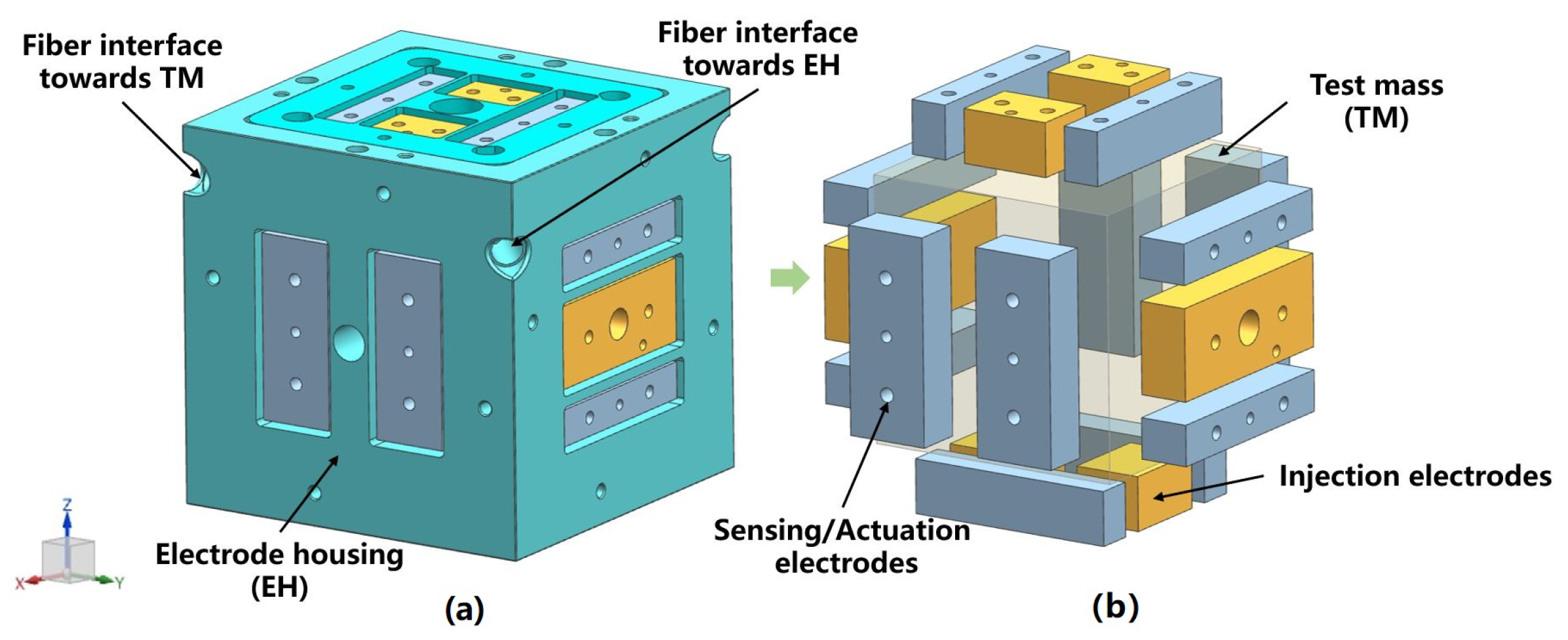
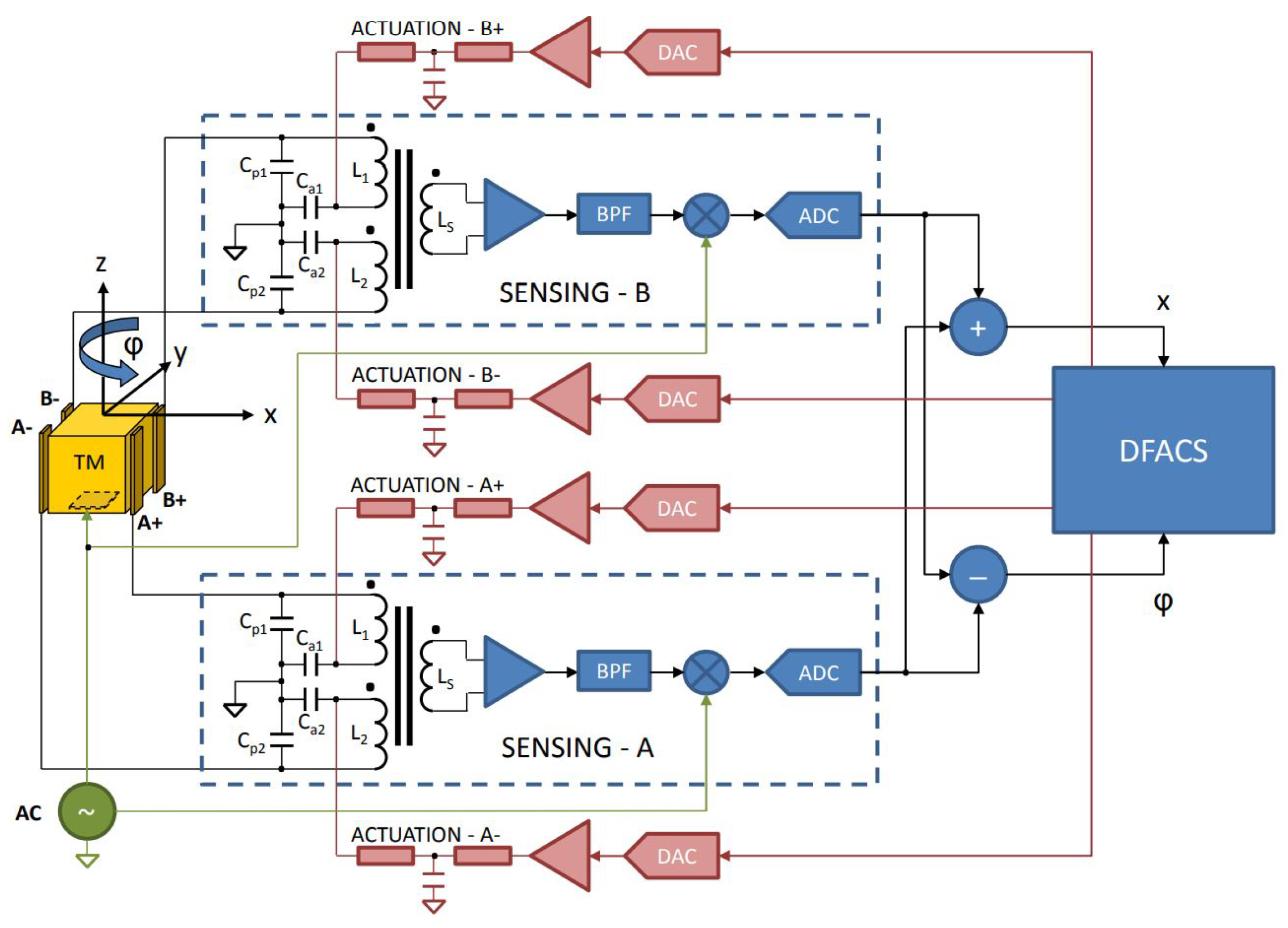

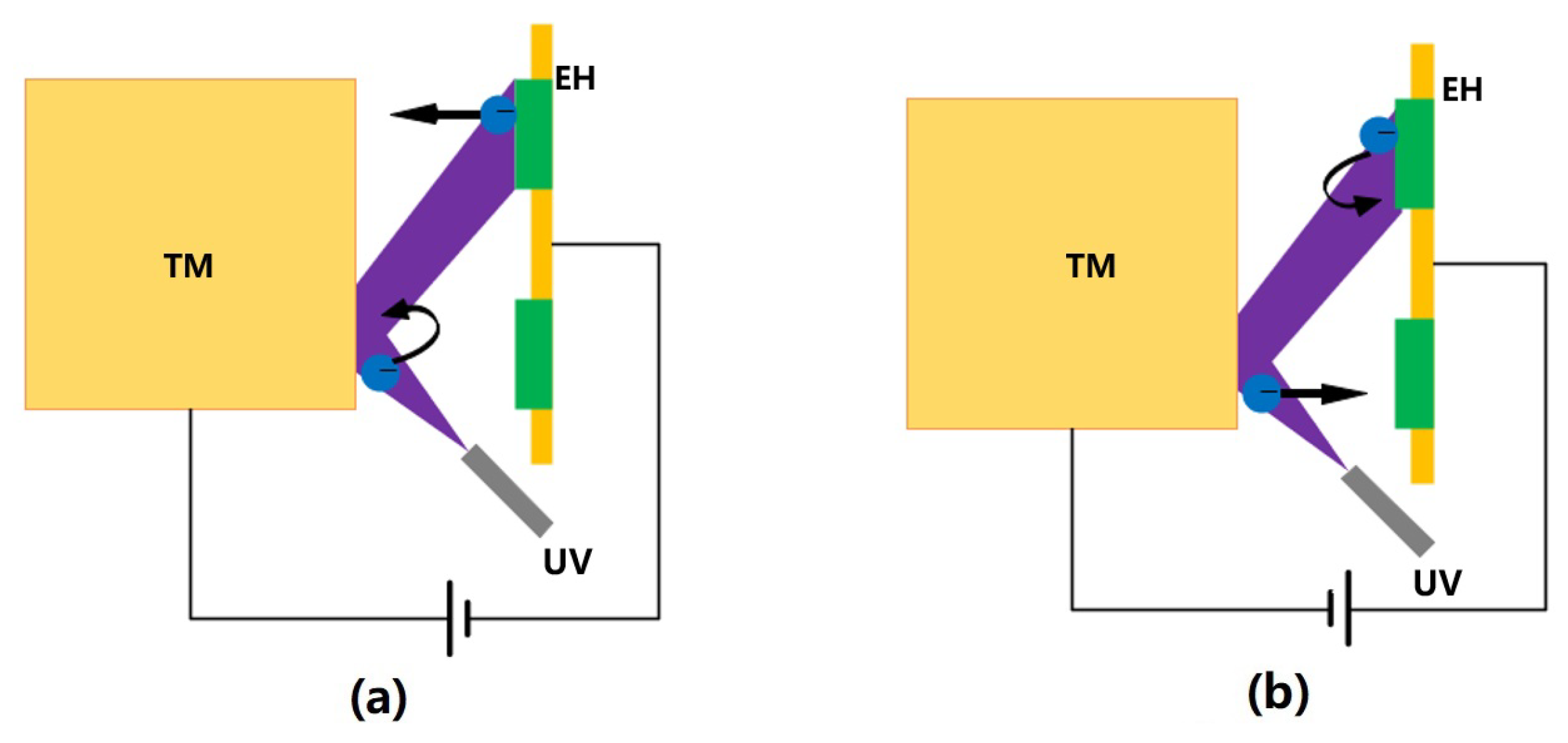
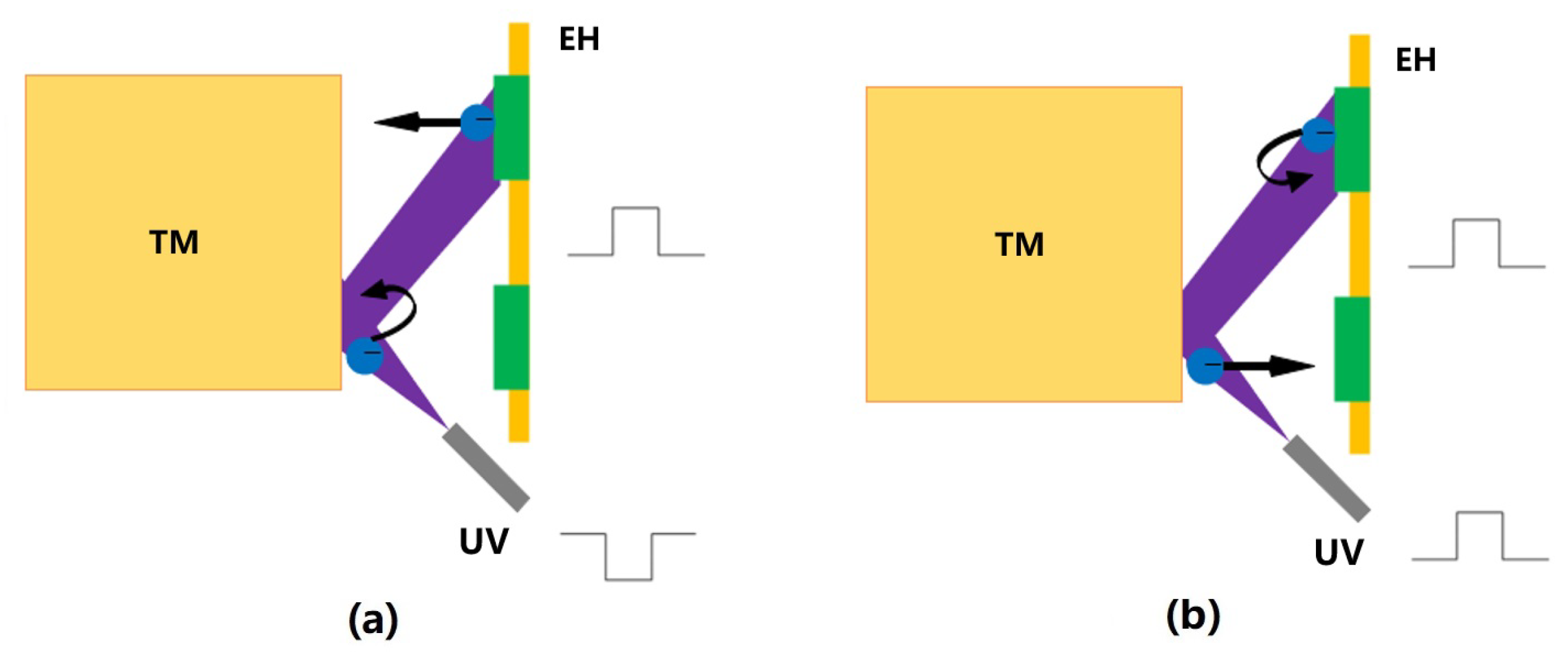
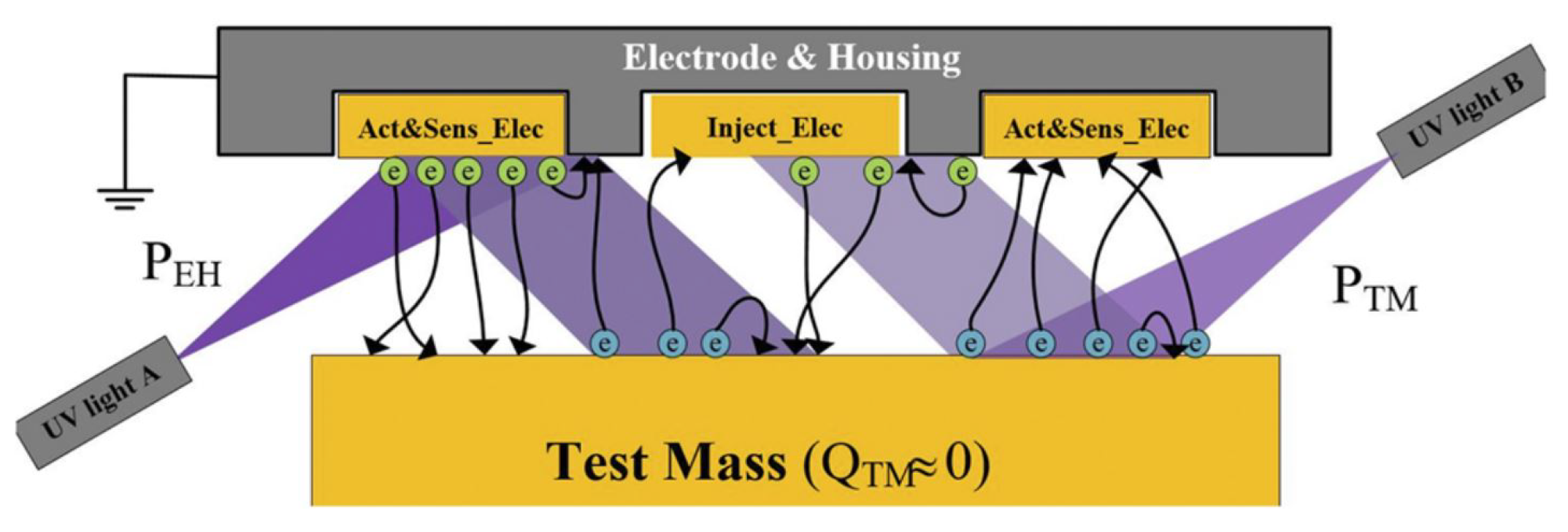
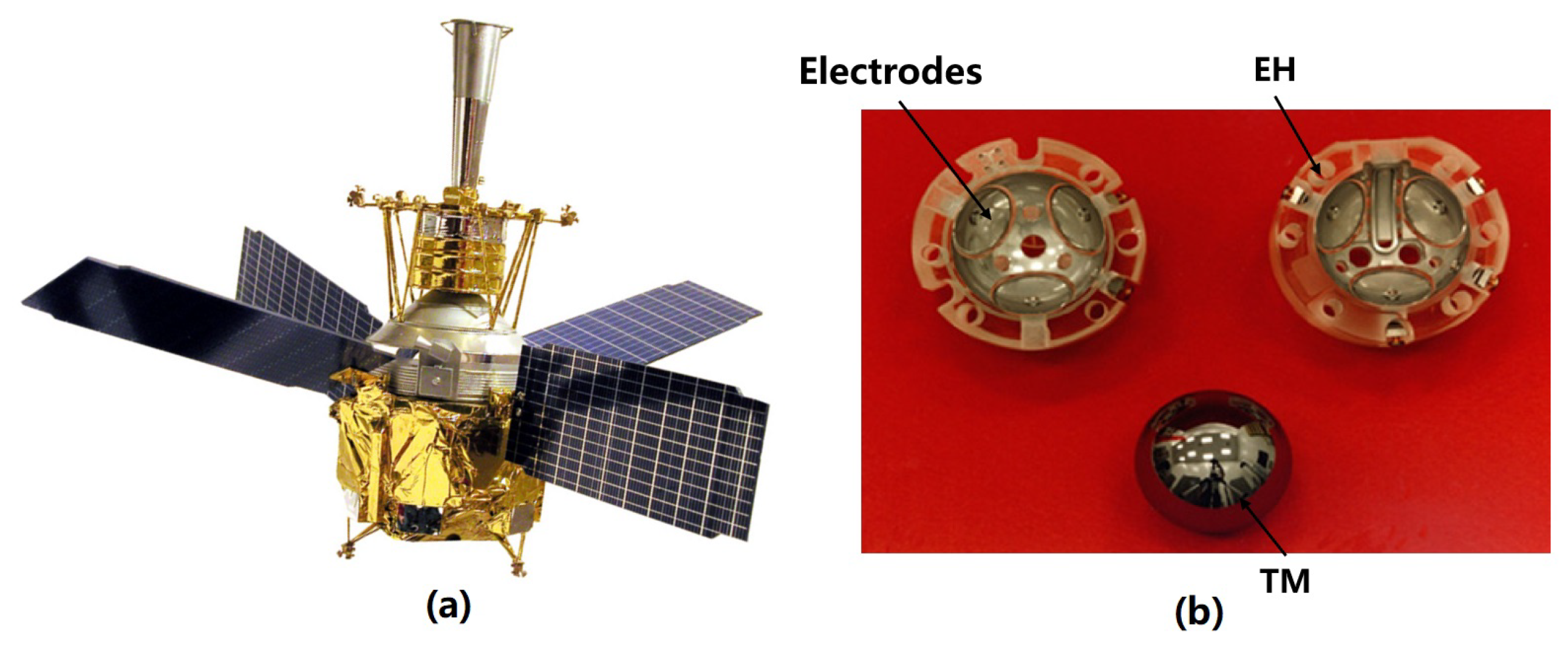
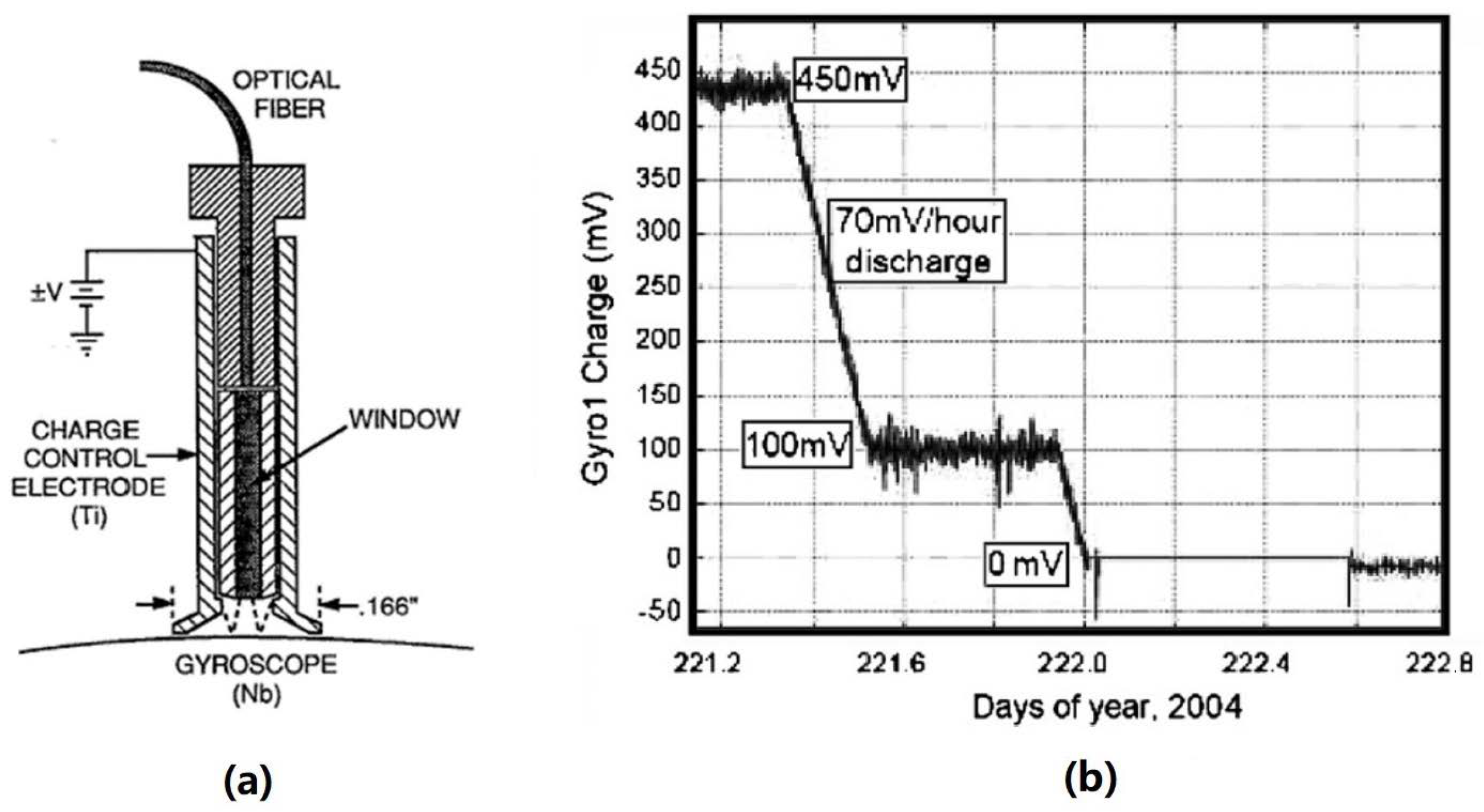
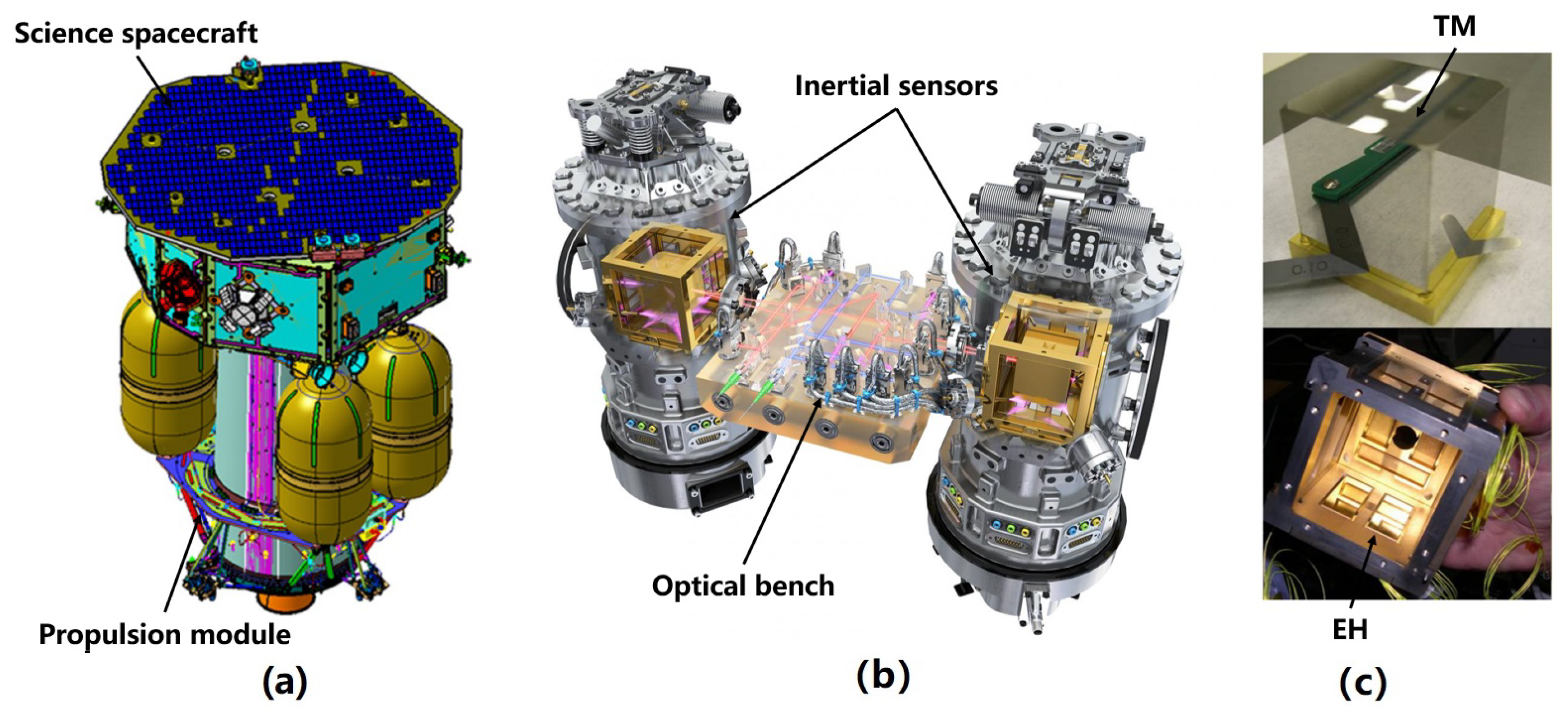
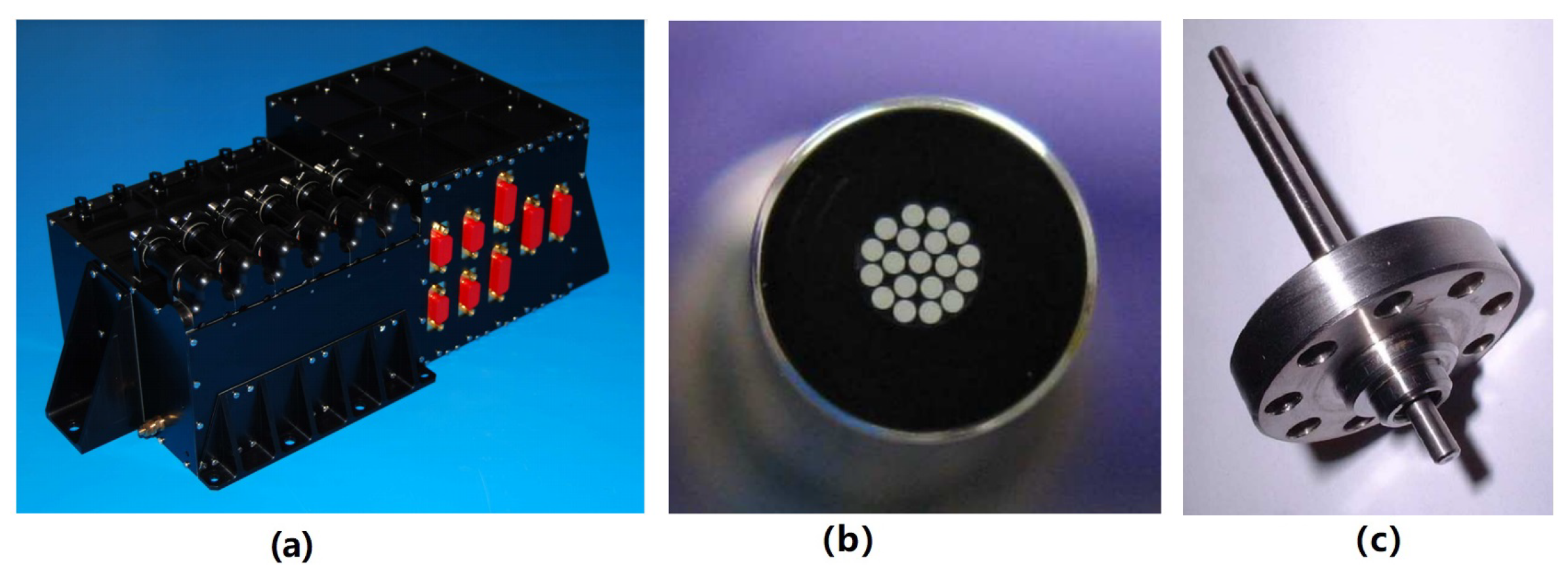
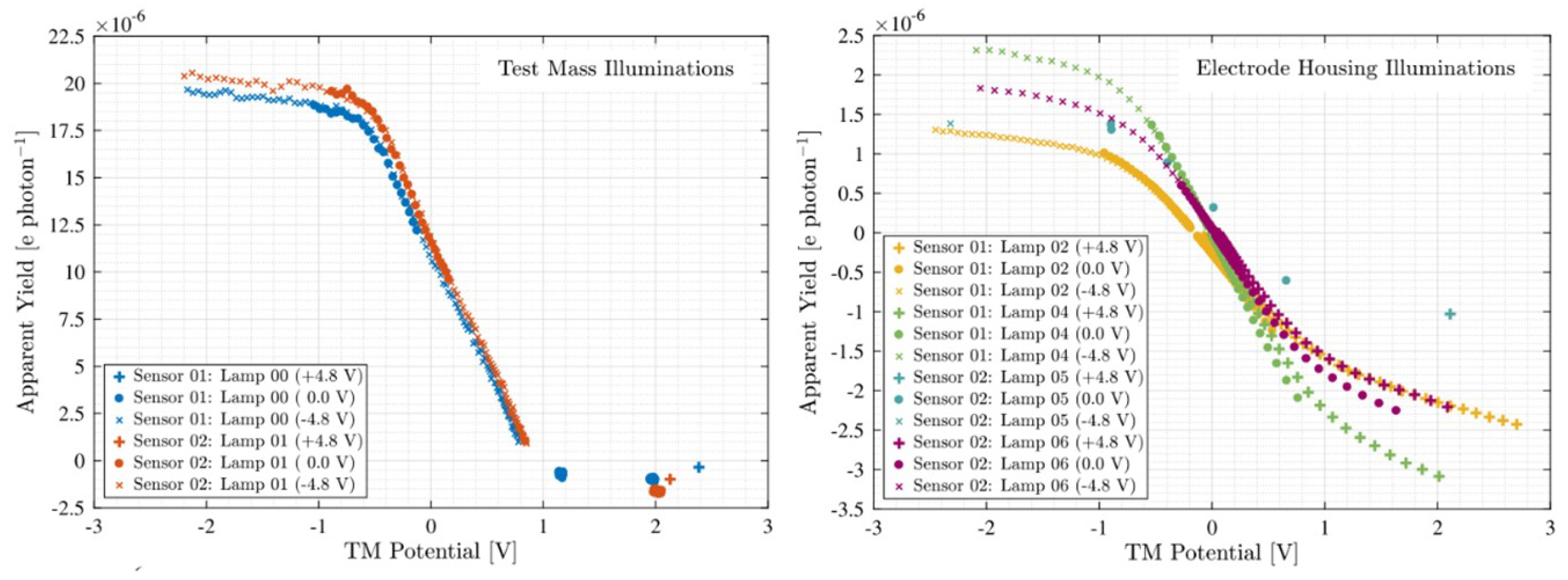

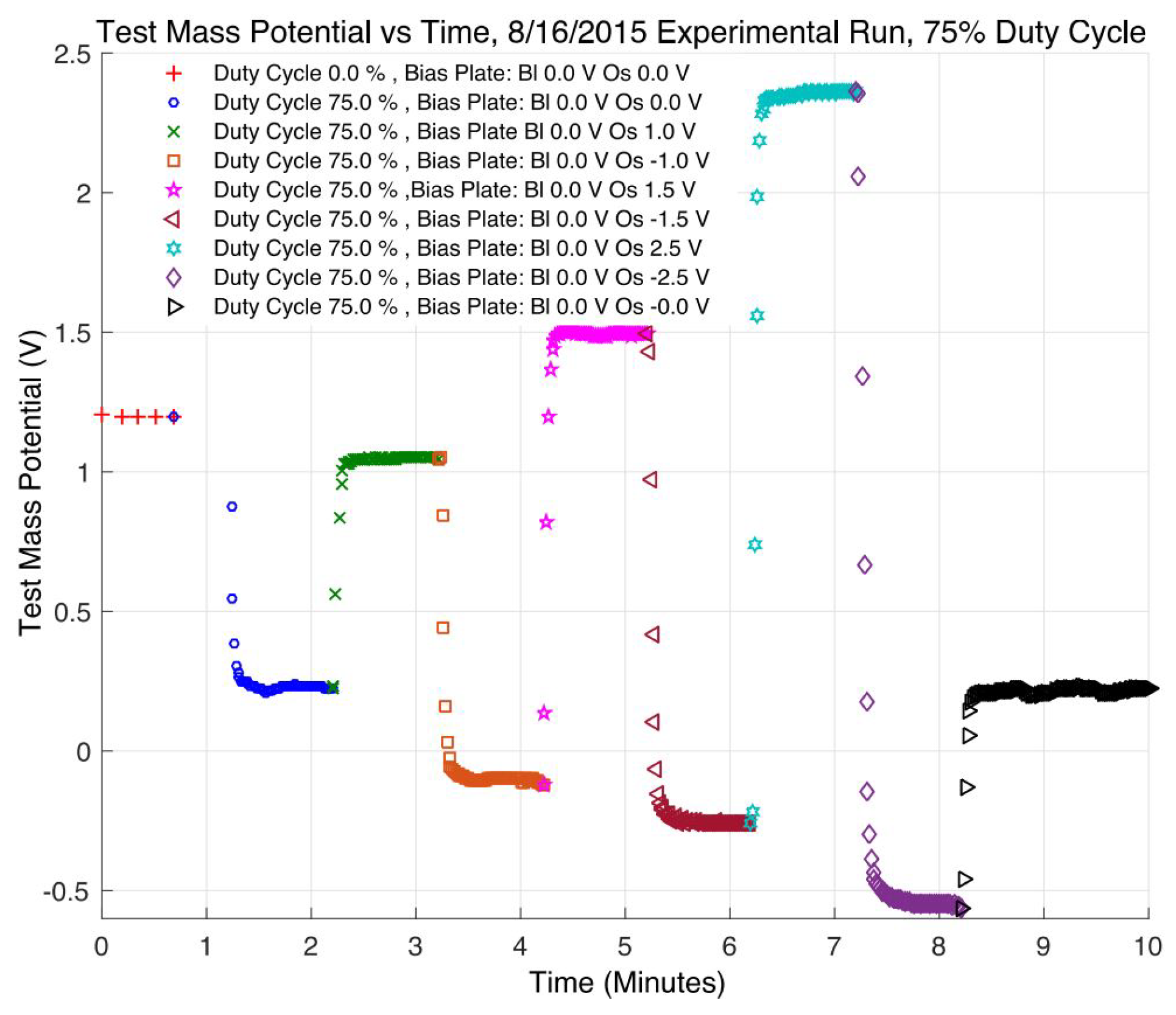
| UV LEDs | Mercury Lamps | |
|---|---|---|
| Package | Small size, light weight. | Large size and weight. |
| Power dissipation | Low power consumption, small heat. | High power consumption and more heat. |
| Lifetime | 10,000–50,000 h. | 2000–10,000 h. |
| Stability | Good stability and can work normally under thermal vacuum, radiation, vibration, and impact. | Sensitive to temperature and adverse conditions. |
| Operation | Current drive, easy to couple. | Long opening time, awkward to operate. |
| Environmental impact | Non-toxic harmless. | Contain toxic metals and will produce RFI and EMI. |
| Modulation performance | Can be modulated at high frequency to achieve high dynamic range in AC CMS. | Not easy to modulate; the dynamic range is limited and cannot be used for AC CMS. |
Disclaimer/Publisher’s Note: The statements, opinions and data contained in all publications are solely those of the individual author(s) and contributor(s) and not of MDPI and/or the editor(s). MDPI and/or the editor(s) disclaim responsibility for any injury to people or property resulting from any ideas, methods, instructions or products referred to in the content. |
© 2023 by the authors. Licensee MDPI, Basel, Switzerland. This article is an open access article distributed under the terms and conditions of the Creative Commons Attribution (CC BY) license (https://creativecommons.org/licenses/by/4.0/).
Share and Cite
Yu, T.; Wang, Y.; Liu, Y.; Wang, Z. High-Precision Inertial Sensor Charge Management Based on Ultraviolet Discharge: A Comprehensive Review. Sensors 2023, 23, 7794. https://doi.org/10.3390/s23187794
Yu T, Wang Y, Liu Y, Wang Z. High-Precision Inertial Sensor Charge Management Based on Ultraviolet Discharge: A Comprehensive Review. Sensors. 2023; 23(18):7794. https://doi.org/10.3390/s23187794
Chicago/Turabian StyleYu, Tao, Yuhua Wang, Yang Liu, and Zhi Wang. 2023. "High-Precision Inertial Sensor Charge Management Based on Ultraviolet Discharge: A Comprehensive Review" Sensors 23, no. 18: 7794. https://doi.org/10.3390/s23187794
APA StyleYu, T., Wang, Y., Liu, Y., & Wang, Z. (2023). High-Precision Inertial Sensor Charge Management Based on Ultraviolet Discharge: A Comprehensive Review. Sensors, 23(18), 7794. https://doi.org/10.3390/s23187794







